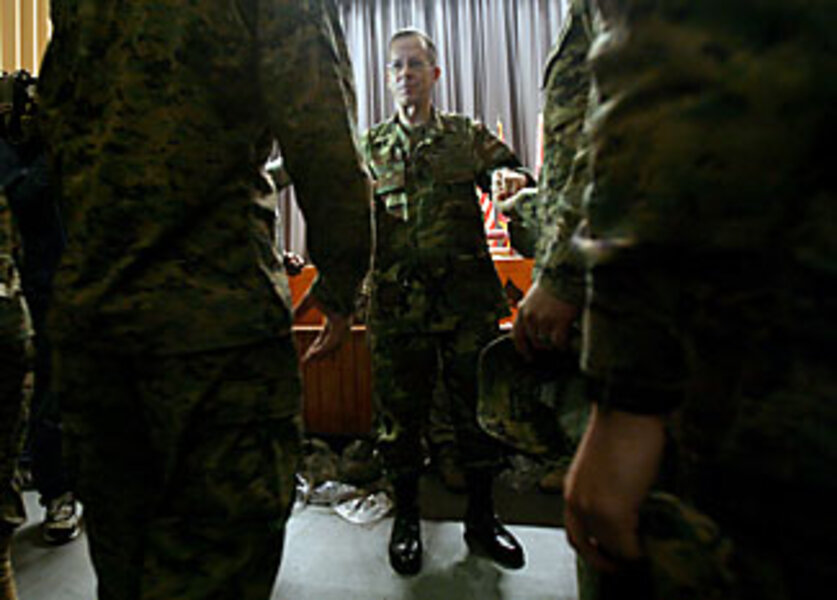Mullen to marines: You have two years to turn tide in Afghanistan
Loading...
| Washington
Adm. Mike Mullen, the nation's top military officer, told marines Monday that they have at most two years to turn around the faltering mission in Afghanistana pep talk aimed at preparing them for the coming surge.
The Pentagon announced Monday that the first of the 30,000 troops to deploy under President Obama's new strategy for Afghanistan will leave in the next few weeks, and though US forces will begin to come back after 18 months, a significant number of troops will remain beyond that date, administration officials have said. Mullen, the chairman of the Joint Chiefs of Staff, visited the Marine post of Camp Lejeune Monday as it readied for a series of deployments to Afghanistan.
Mullen's message was part rallying cry, part primer for the kind of war Gen. Stanley McChrystal, the US commander in Afghanistan, expects to fight.
Why they are going
He reiterated the rationale for the surge: "It is right down the middle of our national interests." Mullen said an effective strategy in South Asia will prevent his "worst nightmare" from coming true: terrorists getting a hold of nuclear weapons.
"If it goes well, it will serve us exceptionally well, and if it goes badly, it is that nightmare that I talked about before," said Mullen, chairman of the Joint Chiefs of Staff.
Yet he told marines to expect a different kind of war. Echoing McChrystal, Mullen implored the Marines to learn as much about the Afghan culture as possible – including some basics of the primary languages (Dari and Pashto) and the many dialects.
Driving home the fundamental tenet of McChrystal's new strategy, Mullen told Marines, that in the end, it's not about killing the Taliban; it is about protecting the population. That means learning enough about it to be effective.
The military collectively learned much about Iraq. But despite eight years of operations in Afghanistan, mot many marines have deployed there. Learning the culture is a "vital part" of the overall approach, he said.
"Learn a little bit about their culture, try to speak their language," Mullen said. "You don't have to speak it perfectly, they don't even mind if you butcher it, quite frankly, but they do appreciate the fact that you take the time to learn a little bit about them."
The deployment schedule
The Pentagon provided details of its deployment plans Monday. The first 16,000 troops will deploy between now and this spring. These include:
• About 1,500 marines from Camp Lejeune who will deploy by the end of the year.
• Another 6,200 from Camp Lejeune will deploy by early spring.
• Some 800 marines from Camp Pendleton, Calif., will deploy in spring 2010.
• The Army is deploying 3,400 soldiers from Fort Drum, N.Y.
• Defense Secretary Robert Gates has also authorized more than 4,000 support troops to deploy by spring 2010.
Most forces are headed to the south and the east of Afghanistan, where the insurgency is strongest. By the end of summer, there will be nearly 150,000 troops in all of Afghanistan – including about 100,000 Americans and nearly 50,000 allied troops.
The logistics of getting the entire force into the landlocked country will occur mostly by air and will challenge military officials as they build up living areas and extend runways to accommodate the new personnel.
See also:
Afghanistan surge: What can it accomplish in 18 months?
Gates, other US officials clarify timeline for Afghanistan pullout
-----
Follow us on Twitter.





